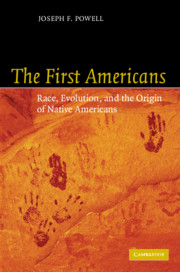Book contents
- Frontmatter
- Contents
- Acknowledgments
- Prologue: The Kennewick controversy
- PART I Race and variation
- PART II The Pleistocene peopling of the Americas
- 5 The Pleistocene and ice-age environments
- 6 Ancient cultures and migration to the Americas
- 7 Kennewick Man and his contemporaries
- 8 Human variation in the Pleistocene
- PART III The First Americans, race and evolution
- References
- Index
8 - Human variation in the Pleistocene
Published online by Cambridge University Press: 21 August 2009
- Frontmatter
- Contents
- Acknowledgments
- Prologue: The Kennewick controversy
- PART I Race and variation
- PART II The Pleistocene peopling of the Americas
- 5 The Pleistocene and ice-age environments
- 6 Ancient cultures and migration to the Americas
- 7 Kennewick Man and his contemporaries
- 8 Human variation in the Pleistocene
- PART III The First Americans, race and evolution
- References
- Index
Summary
WESTERN OLD WORLD
Paleoindians represented by the Clovis and Folsom forms of Upper Paleolithic cultures are part of the long history of Upper or Terminal Pleistocene peoples from across the globe. The Upper Paleolithic is typified by subsistence strategies that emphasize large-mammal hunting with spear and dart technologies in which large, elaborately produced, bifacial stone projectile points; unifacial stone flakes; or microblade play a key role.
There are many Late Pleistocene–Early Holocene human (Homo sapiens sapiens) skeletons in the Old World. In this chapter, a few better-known Upper Paleolithic skeletal specimens have been selected, which may or may not be representative of all 18,000–10,000 yr BP human remains in that part of the globe, but for the purposes of this book they will suffice.
Africa and Egypt
Lothagam 4b, West Turkana
The Lothagam fossil locality in West Turkana, East Africa has produced over 30 fully modern human skeletons dating from 6000 yr BP to 9000 yr BP. Between 1965 and 1975, crews from Michigan State University uncovered the Lothagam locality remains. Nearly all of the skeletons were discovered in good Early Holocene contexts. Angel et al. (1980) performed a reconstruction and analysis of the crania. The Lothagam (lo.4b) skull was the most complete in the sample, and is described here and by Larsen et al. (1991: 151).
- Type
- Chapter
- Information
- The First AmericansRace, Evolution and the Origin of Native Americans, pp. 169 - 184Publisher: Cambridge University PressPrint publication year: 2005



